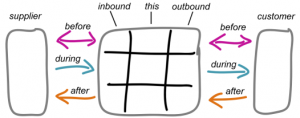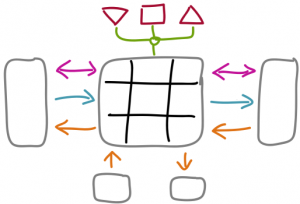Upward and sideways from business-model (short version)
As all-too-usual, the previous ‘how-to’ post ‘Upwards sideways from business-model‘ – to complement the earlier post on transforming from Business Model Canvas to Archimate, to plan and verify the implementation – has turned out to be huge, because it included all of the explanation and context. Here’s a stripped-down version without any of the explanation – just the checklist-questions for the exploration and modelling.
This takes us from the core frame in Enterprise Canvas:
To the complete Enterprise Canvas frame, by including questions on investors and beneficiaries (below the core) and guidance-services for direction, coordination and validation (above the core):
Because the Enterprise Canvas is recursive, the questions here will apply not just to the overall business-model, but to every ‘child’-service and sub-service that we’ve previously identified and mapped in our Archimate models.
Investors and beneficiaries
Quick summary of suggested questions to use in this assessment:
- What energies, resources or other items are or need to be invested in this service (business-model)? From what or whom (the investors) will these be provided, or made available? Via what relationships and transactions? Using a VPEC-T assessment, what values, policies, events, content and trust would apply to each of those relationships and transactions?
- What energies, resources or other items are or need to be returned or extracted from this service (business-model)? To what or whom (the beneficiaries) will these be provided, or made available? Via what relationships and transactions? Using a VPEC-T assessment, what values, policies, events, content and trust would apply to each of those relationships and transactions?
- In what ways are the invested energies and resources used and/or transformed within the service? In what forms is ‘excess value’ extracted and returned from the service as dividends to its beneficiaries?
- What forms of assessment and governance are used to ensure that the balance of investment and dividend is acceptably ‘fair’ to all parties?
Guidance – direction-services
Quick summary of suggested questions to use in this assessment:
- Who or what will provide run-time management for the business-model – such as to plan and manage the operations, allocate resources, and collate and interpret performance-reports, and make run-time tactical decisions?
- Who or what will guide changes to the business-model – such as to research and report on the external environment, and develop strategy?
- Who or what will keep the business-model on track to the vision and values of the organisation and of the overall shared-enterprise – such as to maintain policy, purpose and identity?
- Via what means – the ‘How’ and ‘With-What’ of business-services and business-processes – will all of these requirements be enacted in practice?
- Who or what will provide coordination and choreography for all of this?
- Who or what will provide governance for all of this?
Guidance – coordination-services
Quick summary of suggested questions to use in this assessment:
- Who or what will provide run-time coordination for this business-model, within the various components and processes of itself, with its customers, and with its suppliers and other partners?
- Who or what will guide the execution of change to the business-model – such as via project-management?
- Who or what will define, guide and coordinate longer-term change, to develop and adapt to changes in the broader context for the business-model – such as via portfolio- or programme-management?
- Via what means – the ‘How’ and ‘With-What’ of business-services and business-processes – will all of these requirements be enacted in practice?
- Who or what will define or provide the standards, protocols and policies to guide all of this?
- Who or what will provide governance for all of this?
Guidance – validation-services
Quick summary of suggested questions to use in this assessment:
- Who or what will identify the full set of value-themes that would apply to this business-model?
- For each value-theme in scope, who or what will assist in creating awareness of this value-theme throughout the design, implementation and execution of this business-model, both within the organisation and with its customers, suppliers and other partners?
- Who or what will assist in developing and/or embedding the skills and capability to execute run-time support for each value-theme in scope?
- Who or what is responsible for executing the required support for each value-theme at run-time? Are they fully aware of and capable of enacting those responsibilities at run-time to the standards required? Via what means – the ‘How’ and ‘With-What’ of business-services and business-processes – will all of these requirements be enacted in practice?
- Who or what will monitor and verify compliance (and more) to the required standards of support for each value-theme in scope?
- Who or what is responsible for ‘closing the loop’ to support continuous improvement on each value-theme in scope?
- Who or what will define or provide the standards, protocols and policies to guide all of this?
- Who or what will provide governance for all of this?
—
Over to you: hope it’s useful, anyway.


Leave a Reply